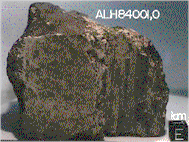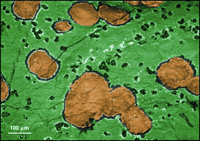Life on Mars?
Written by Marek Gierlinski
This article was
placed on the Web on November 17, 1996 as a part of AstroNews.

 In
the beginning of August 1996 the scientists from NASA Johnson
Space Center and Stanford University have reported the evidence
that strongly suggests primitive life may have existed on Mars
more than 3.6 billion years ago. They found organic molecules,
several mineral features characteristic of biological activity,
and - the most striking - microscopic fossils of puzzling bacterium-like
shape (pictures on the right). Nevertheless, those indirect
evidences are not yet convincing.
In
the beginning of August 1996 the scientists from NASA Johnson
Space Center and Stanford University have reported the evidence
that strongly suggests primitive life may have existed on Mars
more than 3.6 billion years ago. They found organic molecules,
several mineral features characteristic of biological activity,
and - the most striking - microscopic fossils of puzzling bacterium-like
shape (pictures on the right). Nevertheless, those indirect
evidences are not yet convincing.
 The ancient life remnants were found in the
meteorite of the Martian origin (picture on the left). The
1.9-kilogram meteorite was found in Antarctica in 1984 and aptly
named ALH 84001 (it's a nice name, isn't it?). The radiometric
dating of the find shows that the rock congealed from magma 4.5
billion year ago. It was only about 100 million years after the
planet formed. Some billion years later - perhaps 3.6 billion
years ago - the impact of the meteorite shattered the rock, leaving
fractures where minerals formed. Much later, about 16 million
years ago, the impact of another meteorite launched the rock into
space. After the long journey through the interplanetary space
about 13,000 years ago it finally entered the Earth's atmosphere
and crashed into the Antarctica.
The ancient life remnants were found in the
meteorite of the Martian origin (picture on the left). The
1.9-kilogram meteorite was found in Antarctica in 1984 and aptly
named ALH 84001 (it's a nice name, isn't it?). The radiometric
dating of the find shows that the rock congealed from magma 4.5
billion year ago. It was only about 100 million years after the
planet formed. Some billion years later - perhaps 3.6 billion
years ago - the impact of the meteorite shattered the rock, leaving
fractures where minerals formed. Much later, about 16 million
years ago, the impact of another meteorite launched the rock into
space. After the long journey through the interplanetary space
about 13,000 years ago it finally entered the Earth's atmosphere
and crashed into the Antarctica.
 How do we know this guy is from Mars? The
meteorite was found to contain some gas trapped in its interior.
Analysis showed that the composition of this gas was nearly identical
to that of the atmosphere on Mars, as measured by the Viking
Landers in 1976. Each point on the graph (picture on the right -
click on it to see the full scale image) shows the concentration
of one of the gases in the Martian atmosphere (vertical axis). The
horizontal axes shows the same for the gas from the meteorite.
For a perfect correlation, the points would all fall precisely on
the diagonal line. The close correlation is persuasive evidence
that this meteorite actually came from Mars.
How do we know this guy is from Mars? The
meteorite was found to contain some gas trapped in its interior.
Analysis showed that the composition of this gas was nearly identical
to that of the atmosphere on Mars, as measured by the Viking
Landers in 1976. Each point on the graph (picture on the right -
click on it to see the full scale image) shows the concentration
of one of the gases in the Martian atmosphere (vertical axis). The
horizontal axes shows the same for the gas from the meteorite.
For a perfect correlation, the points would all fall precisely on
the diagonal line. The close correlation is persuasive evidence
that this meteorite actually came from Mars.
 Inside
the meteorite using the sophisticated laser techniques the
scientists found abundant polycyclic aromatic hydrocarbons
(PAHs). However, these large organic molecules are common in some
interplanetary dust particles, and may origin from non-biological
reactions, so they do not constitute any evidence of life. But
that's not all. The evidence is strengthen by the existence of
microscopic mineral deposits. The most abundant mineral,
carbonate, forms globules about 50 micrometers across (picture on
the left shows a false-color backscatter electron image). The
similar structures are typical for bacteria activity. In
addition, the larger globules have manganese-containing cores and concentric
rings of iron carbonate and iron sulfides. This strongly
resembles the so-called "magnetofossils" left in terrestrial
sediments by bacteria that made the mineral to guide them along
Earth's magnetic field lines.
Inside
the meteorite using the sophisticated laser techniques the
scientists found abundant polycyclic aromatic hydrocarbons
(PAHs). However, these large organic molecules are common in some
interplanetary dust particles, and may origin from non-biological
reactions, so they do not constitute any evidence of life. But
that's not all. The evidence is strengthen by the existence of
microscopic mineral deposits. The most abundant mineral,
carbonate, forms globules about 50 micrometers across (picture on
the left shows a false-color backscatter electron image). The
similar structures are typical for bacteria activity. In
addition, the larger globules have manganese-containing cores and concentric
rings of iron carbonate and iron sulfides. This strongly
resembles the so-called "magnetofossils" left in terrestrial
sediments by bacteria that made the mineral to guide them along
Earth's magnetic field lines.
 The
most provocative evidence comes from high-resolution microscopic
images on which one can see the "ovoids", as the
authors say, that can be interpreted as the microfossils from
Mars. But they also add: "That is an interpretation; we have
no independent evidence." At 20 to 100 nanometers in length,
the objects are 100 times smaller than the smallest microfossils
of ancient bacteria ever found on Earth. The opponents claim one
can form little blobs on rocks with all kinds of chemical
precipitates. What's lacking is evidence other than shape that
these forms were once living. On the other hand, at least one of
the fossils is long and apparently segmented (picture on the
right, click on it to see the full-scale image), reminiscent of
some microfossils from Earth's Precambrian era.
The
most provocative evidence comes from high-resolution microscopic
images on which one can see the "ovoids", as the
authors say, that can be interpreted as the microfossils from
Mars. But they also add: "That is an interpretation; we have
no independent evidence." At 20 to 100 nanometers in length,
the objects are 100 times smaller than the smallest microfossils
of ancient bacteria ever found on Earth. The opponents claim one
can form little blobs on rocks with all kinds of chemical
precipitates. What's lacking is evidence other than shape that
these forms were once living. On the other hand, at least one of
the fossils is long and apparently segmented (picture on the
right, click on it to see the full-scale image), reminiscent of
some microfossils from Earth's Precambrian era.
The story seems to go on. In the end of October, the three
British scientists from The Open University and the British
Museum of Natural History announced the discovery of the organic
matter in two other meteorites of Martian origin. One of them,
EETA 79001, was aged to be about 150 million year old. That makes
the find much younger then 3.6 billion-year ALH 84001. It
suggests that life existed on Mars until at least the date the
rock formed, which is much closer to the present than scientists
once thought life could exist.
Does really life exist (or existed) on Mars? For the definite
evidence we have to wait. Three different space missions to Mars
are about to start just now. Mars Global Surveyor was
successfully launched on November 7. It is going to reach the Red
Planet in September 1997 and than will be inserted into circular
orbit. The goal of the mission is to make a detailed maps of the
Martian surface. The Russian spacecraft Mars'96 was
launched on November 16, but failed after few hours - it remains on
Earth's orbit and will fall
down. Mars
Pathfinder launch is scheduled for December 2. After the the
few months in space it will touch down in Ares Vallis on July 4,
1997. The spacecraft will deploy a small rover - the Sojourner -
that will investigate the nearby surroundings. The mission will
explore geology, morphology, geochemistry, magnetic properties
and soil mechanics of the surface.
Or maybe we should wait until the first human expedition to
Mars. It will not begin soon - that's sure. However, shall the
people find any microorganisms on Mars, the vision of Herbert
George Wells depicting Martians killed by Earth's germs can come
true in quite opposite way...

 In
the beginning of August 1996 the scientists from NASA Johnson
Space Center and Stanford University have reported the evidence
that strongly suggests primitive life may have existed on Mars
more than 3.6 billion years ago. They found organic molecules,
several mineral features characteristic of biological activity,
and - the most striking - microscopic fossils of puzzling bacterium-like
shape (pictures on the right). Nevertheless, those indirect
evidences are not yet convincing.
In
the beginning of August 1996 the scientists from NASA Johnson
Space Center and Stanford University have reported the evidence
that strongly suggests primitive life may have existed on Mars
more than 3.6 billion years ago. They found organic molecules,
several mineral features characteristic of biological activity,
and - the most striking - microscopic fossils of puzzling bacterium-like
shape (pictures on the right). Nevertheless, those indirect
evidences are not yet convincing.

 Inside
the meteorite using the sophisticated laser techniques the
scientists found abundant polycyclic aromatic hydrocarbons
(PAHs). However, these large organic molecules are common in some
interplanetary dust particles, and may origin from non-biological
reactions, so they do not constitute any evidence of life. But
that's not all. The evidence is strengthen by the existence of
microscopic mineral deposits. The most abundant mineral,
carbonate, forms globules about 50 micrometers across (picture on
the left shows a false-color backscatter electron image). The
similar structures are typical for bacteria activity. In
addition, the larger globules have manganese-containing cores and concentric
rings of iron carbonate and iron sulfides. This strongly
resembles the so-called "magnetofossils" left in terrestrial
sediments by bacteria that made the mineral to guide them along
Earth's magnetic field lines.
Inside
the meteorite using the sophisticated laser techniques the
scientists found abundant polycyclic aromatic hydrocarbons
(PAHs). However, these large organic molecules are common in some
interplanetary dust particles, and may origin from non-biological
reactions, so they do not constitute any evidence of life. But
that's not all. The evidence is strengthen by the existence of
microscopic mineral deposits. The most abundant mineral,
carbonate, forms globules about 50 micrometers across (picture on
the left shows a false-color backscatter electron image). The
similar structures are typical for bacteria activity. In
addition, the larger globules have manganese-containing cores and concentric
rings of iron carbonate and iron sulfides. This strongly
resembles the so-called "magnetofossils" left in terrestrial
sediments by bacteria that made the mineral to guide them along
Earth's magnetic field lines.